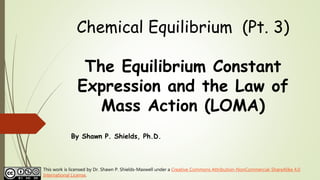
Chem 2 - Chemical Equilibrium III: The Equilibrium Constant Expression and the Law of Mass Action (LOMA)
- 1. Chemical Equilibrium (Pt. 3) The Equilibrium Constant Expression and the Law of Mass Action (LOMA) By Shawn P. Shields, Ph.D. This work is licensed by Dr. Shawn P. Shields-Maxwell under a Creative Commons Attribution-NonCommercial-ShareAlike 4.0 International License.
- 2. At equilibrium… Macroscopic observables have stopped changing. The forward and reverse reaction rates are equal.
- 3. Recall: Equilibrium Constant K and Rate Constants 2 NO2 N2O4 k1[NO2]2 = k1[N2O4] 𝐊 = 𝐤 𝟏 𝐤−𝟏 = 𝐍 𝟐 𝐎 𝟒 𝐍𝐎 𝟐 𝟐 The equilibrium constant K is the ratio of the forward and reverse rate constants. k1 k1
- 4. The Equilibrium Constant Expression Experiments done by Guldburg and Waage (1864-1879) demonstrated the ratio of products to reactants is always constant under a certain set of experimental conditions. (This is a simplified statement.)
- 5. The Law of Mass Action Consider the generalized reaction aA + bB ⇌ cC + dD Reactants A and B Products C and D coefficients
- 6. The Law of Mass Action For the reaction 𝐚𝐀 + 𝐛𝐁 ⇌ 𝐜𝐂 + 𝐝𝐃 The relationship between the value of the equilibrium constant K and the concentrations of reactants and products is 𝐊 = 𝐂 𝐜 𝐃 𝐝 𝐀 𝐚 𝐁 𝐛 𝐩𝐫𝐨𝐝𝐮𝐜𝐭𝐬 𝐫𝐞𝐚𝐜𝐭𝐚𝐧𝐭𝐬
- 7. The Law of Mass Action What happens if we reverse the reaction? 𝐜𝐂 + 𝐝𝐃 ⇌ 𝐚𝐀 + 𝐛𝐁 The relationship between the value of the equilibrium constant K and the concentrations of reactants and products is still products over reactants! 𝐊 = 𝐀 𝐚 𝐁 𝐛 𝐂 𝐂 𝐃 𝐝 𝐩𝐫𝐨𝐝𝐮𝐜𝐭𝐬 𝐫𝐞𝐚𝐜𝐭𝐚𝐧𝐭𝐬
- 8. The Law of Mass Action 𝐚𝐀 + 𝐛𝐁 ⇌ 𝐜𝐂 + 𝐝𝐃 This relationship is true no matter the initial distribution (relative amounts) of reactants and products! 𝐊 = 𝐂 𝐜 𝐃 𝐝 𝐀 𝐚 𝐁 𝐛 𝐩𝐫𝐨𝐝𝐮𝐜𝐭𝐬 𝐫𝐞𝐚𝐜𝐭𝐚𝐧𝐭𝐬
- 9. 𝐏 𝐍𝐎 𝟐 𝐏 𝐍 𝟐 𝐎 𝟒 “kinetics ” Remember… Once we reached the “equilibrium” part of the experiment, we ended up with 0.50 atm NO2 and 0.25 atm N2O4 … And it didn’t matter if we started with all products or all reactants! Time (s) P (atm) 0.75 0.50 0.25 1.0 𝐏 𝐍𝐎 𝟐 𝐏 𝐍 𝟐 𝐎 𝟒
- 10. Equilibrium Constant K is Unitless Why is the value for K unitless? 𝐚𝐀 + 𝐛𝐁 ⇌ 𝐜𝐂 + 𝐝𝐃 Each concentration in the equilibrium constant expression is divided by a “standard concentration” of 1.0 M. 𝐊 = 𝐂 𝐜 𝟏. 𝟎 𝐃 𝐝 𝟏. 𝟎 𝐀 𝐚 𝟏. 𝟎 𝐁 𝐛 𝟏. 𝟎 All molarity units cancel out!
- 11. Equilibrium Constant K is Unitless 𝐚𝐀 + 𝐛𝐁 ⇌ 𝐜𝐂 + 𝐝𝐃 When we divide by a standard concentration, we are left with “effective concentrations” or “activities” (a). 𝐊 = 𝒂 𝑪 𝐜 𝒂 𝑫 𝐝 𝒂 𝑨 𝐚 𝒂 𝑩 𝐛 “activity” can be though of as the “presence” of the reactant or product
- 12. Gases and the Equilibrium Constant Expression 𝐚𝐀 𝒈 + 𝐛𝐁 𝒈 ⇌ 𝐜𝐂 𝒈 + 𝐝𝐃(𝒈) The Law of Mass Action holds for gases in equilibrium, as well. 𝑷 𝑪 𝐜 represents the partial pressure of gas C, etc. 𝐊 = 𝑷 𝑪 𝐜 𝑷 𝑫 𝐝 𝑷 𝑨 𝐚 𝑷 𝑩 𝐛
- 13. Gases and the Equilibrium Constant Expression 𝐚𝐀 𝒈 + 𝐛𝐁 𝒈 ⇌ 𝐜𝐂 𝒈 + 𝐝𝐃(𝒈) Each partial pressure is divided by a standard pressure (1 atm), so the K for gaseous systems is also unitless! 𝐊 = 𝑷 𝑪 𝐜 𝑷 𝑫 𝐝 𝑷 𝑨 𝐚 𝑷 𝑩 𝐛 Partial pressures for gases are given in “activities”, just like solutions.
- 14. Example 1: The Equilibrium Constant Expression 2 NO2 N2O4 Write the equilibrium constant expression for the following reaction:
- 15. Example 1 Solution: The Equilibrium Constant Expression 2 NO2 N2O4 Write the equilibrium constant expression for the following reaction: 𝐊 = 𝐍 𝟐 𝐎 𝟒 𝐍𝐎 𝟐 𝟐 The coefficient for N2O4 is 1
- 16. Calculating the Value of the Equilibrium Constant 2 NO2 N2O4 The value for the equilibrium constant K can be calculated by inserting the equilibrium concentrations (or partial pressures) into the equilibrium constant expression.
- 17. Example 2: Calculating the Value of the Equilibrium Constant 2 NO2 N2O4 What is the value of K when the concentration of NO2 (at equilibrium) is 0.0165 M and the concentration of N2O4 is 0.0417 M?
- 18. Example 2 Solution: Calculating the Value of the Equilibrium Constant 2 NO2 N2O4 The equilibrium NO2 conc is 0.0165 M and N2O4 is 0.0417 M: 𝐊 = 𝐍 𝟐 𝐎 𝟒 𝐍𝐎 𝟐 𝟐 = 𝟎.𝟎𝟒𝟏𝟕 𝟎.𝟎𝟏𝟔𝟓 𝟐 = 𝟏𝟓𝟑 Remember, K is unitless!
- 19. Example 3: Reversing the Reaction and the Equilibrium Constant Expression N2O4 2 NO2 The equilibrium NO2 conc is still 0.0165 M and N2O4 is 0.0417 M. What is the value for K?
- 20. Example 3 Solution: Reversing the Reaction and the Equilibrium Constant Expression N2O4 2 NO2 The equilibrium NO2 conc is still 0.0165 M and N2O4 is 0.0417 M… 𝐊 = 𝐍𝐎 𝟐 𝟐 𝐍 𝟐 𝐎 𝟒 = 𝟎.𝟎𝟏𝟔𝟓 𝟐 𝟎.𝟎𝟒𝟏𝟕 = 𝟔. 𝟓𝟑 × 𝟏𝟎−𝟑 This value is just K-1 for the previous reaction!
- 21. Example 4: The Equilibrium Constant Value and Expression with Partial Pressures 2 NO2 N2O4 The equilibrium NO2 partial pressure is 1.26 atm and N2O4 is 0.199 atm: NOTE: These are not the same experimental conditions from the previous problem.
- 22. Example 4 Solution: The Equilibrium Constant Expression with Partial Pressures 2 NO2 N2O4 The equilibrium NO2 partial pressure is 1.26 atm and N2O4 is 0.199 atm: 𝐊 = 𝑷 𝑵 𝟐 𝑶 𝟒 𝑷 𝑵𝑶 𝟐 𝟐 = 𝟎.𝟏𝟗𝟗 𝟏.𝟐𝟔 𝟐 = 𝟎. 𝟏𝟐𝟓 NOTE: These are not the same experimental conditions from the previous problem.
- 23. Next up, Properties of the Equilibrium Constant K (Pt 4)
